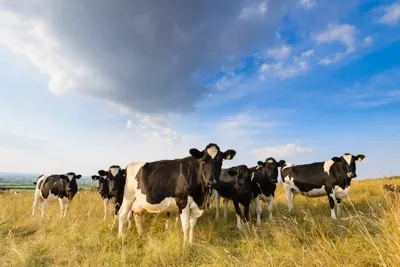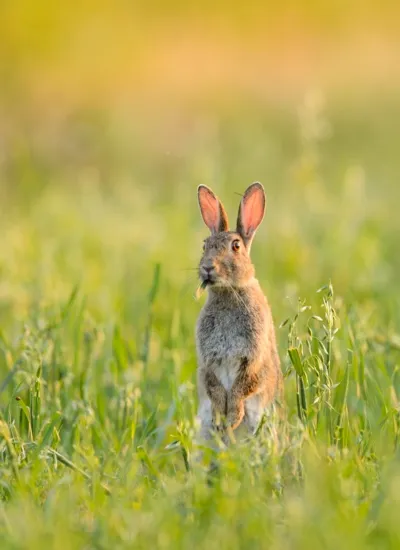In the Oxford English Dictionary, ‘organic’ is defined as ‘relating to or derived from living matter'. But when used in the context of farming, the definition evolves: “food or crops produced without the use of chemical fertilizers, pesticides or other artificial chemical. For its advocates, organic means good for the environment, wildlife, farm animals and us. For its detractors, it is faddish, uneconomical and elitist – producing food that is too expensive for most people.
But what is the reality on the ground? I was curious to see what an organic farm looked and felt like. How does it work – are organic farms economical and can they feed a growing population? And is there really more wildlife on an organic farm than a conventional one?
In 2014 there were 3695 ‘agricultural producers’ who had received organic accreditation in Britain and they are a mixed bag – arable, pasture, horticulture, fruit farms and a mix of some or all of these. So I decided to head to the top – to the farm of Soil Association’s chief executive Helen Browning. If you’re championing a cause, surely your own farm must be a model example.

The Brownings have tenanted 1,350-acre Eastbrook Farm from the Church of England since 1950 but it was only when Helen took the farm on from her father in 1986 at the age of 24 that the conversion to organic began. Today Helen is still young for a farmer in modern Britain but doing something so unconventional at such a young age certainly raised eyebrows among her neighbours and mostly male peers.
When I meet her to explore her farm, she comes across as battle-hardened but not bitter – and gives off a powerful sense – without being preachy – that she feels she is doing the right thing.
But is there evidence to back up this resolve? The farm runs south in a narrow strip from the village of Bishopstone up into the White Horse Downs, over the Ridgeway path and beyond into a sparsely populated little visited chalk plateau. At first glance, there is nothing obvious to suggest that this is a fairytale land of wildlife wonders. But as we take a track up onto the downs, major differences to her neighbours start to reveal themselves.
First Helen shows me her grasslands – the larder for her herds of pigs, cattle and sheep. But grass is a misnomer. Instead of the uniform green, green grass that I know from my Somerset pasture homeland, this is a blend of legumes, herbs and flowers as well as grasses. About half the farm comprises these leys. Some of the plants I recognize – red and white clover and trefoil – but Helen points out sanfoin, lucerne and chicory.
“Are these good for wildlife?” I ask.
“Well, yes,” she replies, “but it’s really the livestock that I’m hoping will benefit. We sow these plants in a variety of different combinations depending on what we want to achieve. Some plants, for example, as well as providing nourishment help build resistance to certain parasites or diseases.” Pulling out a map, she points to a few areas of permanent downland pasture “where you’ll find the orchids and butterflies” – these, in particular, the dry cleft near Bishopstone known as Eastbrook Valley are difficult to plough so are regarded as semi natural grassland by conservationists and are now protected.
And the nearest grazers are the 2000 free-ranging sows– mostly Saddlebacks crossed with a large white boar. The pigs are the engine room of the farm and Helen uses them to explain the dynamics of the farm. After the leys are sown and have been used for 2 years for silage, ley and grazing, the pigs are turned out onto them to feed and farrow (give birth). They are given pig feed as well but their rooting in the ley cleans out any weeds and add fertility to the soil – “so no need for chemical herbicides or fertilisers”. After the pigs have worked over the ley, they are moved on (some 3300 are sold each year) and a crop of root vegetables is sown to take advantage of the soil fertilized by their dung before winter rains wash it all away.
“It’s important to move the pigs on so that every farrowing is on fresh ground. This reduces disease and parasite build up – and we can catch the fertility that might otherwise end up on the water table.” The next part of the rotation is to plant arable crops on the land.
The root vegetables are used as supplementary animal feed and so money is saved.
The dairy arm of the Eastbrook operation is equally fascinating. There are 180 British Friesians on the farm producing 7000 litres per cow per annum. Some 60 per cent of this is produced from forage – ie grazing in the open fields, compared to a national average of around 2200 litres. The farm does use concentrated dairy feeds (organic versions are very expensive) but with such a high level of forage, they are able to make significant savings – so cost of feed per litre is just 5.54p compared to an average of 9p on conventional farms. As Helen says “grass/forage is the natural diet of the cow. It is also the cheapest feed available and grows very well in the UK.”

But while grassland if highly productive under good organic management, Helen has found that arable is harder with yields between 1.5-2.5 tonnes per acre of wheat, oats, barley and beans on the 300-400 acres annually devoted to it. The main challenges involve the heavy clay soils of the valley and the preponderance of weeds in the absence of chemical herbicides. Still, she is constantly experimenting and researching. For example, this year, “combining spring beans and oats to combat weeds and increase yield looks very encouraging.”
I ask Helen if she honestly feels that her system works financially. She laughs “well, the show is still on the road 30 years later – we pay staff fairly and suppliers promptly. And we have money to invest. So yes, it works.” But that’s not all – she wants a farm to be proud of: “a happy workforce (of 15), healthy happy animals, productive crops and loads of wildlife.”
But how many organic farmers are making a decent living like Helen? Farmer Mike Gooding, who farms in neighbouring Oxfordshire, has adopted many organic practices for similar reasons to Helen and offers a broad picture of the economics. “We’ve primarily turned to organic because low input (cost control) systems with multi-enterprises running together are built around crop rotations and fertility provided by clover and livestock.
Secondly, in managing 1,850 acres, I seek to 'de-risk' the business by avoiding violent market fluctuations, and the organic market has been less volatile, allowing for more predictable farm planning, budgeting, and investment strategy.”
Up to this point we haven't talked about the wildlife very much, yet I’ve noticed that there seem to be good numbers of butterflies even though it is late autumn. Flocks of starlings skitter over the pig fields and I see corn buntings, yellowhammers and skylarks, all of which are declining nationally. I’ve walked widely on the Ridgeway and the downlands from Avebury to the Thames and I have to admit that the wildlife on the farm compares well to nearby nature reserves such as Fyfield Down or Pewsey Downs NNRs. And some parts of the farmed landscape have been deserts. But none of my anecdotes are quantifiable.

As we crest the downs and head into a shallow valley on the plateau, we meet wildlife photographer Elliott Neep returning from a series of wildlife-watching hides that he’s built on Helen’s land. I’ve worked with Elliott before during my time on BBC Wildlife Magazine and it’s no coincidence he’s here. He shows me some of the wildlife hotspots on the farm and points out how the rotation system and lack of chemical interference delivers the sheer tonnage of invertebrate life that support the more obvious species.
But the thing that convinces me more than anything is that Eliot has set up his new wildlife photography business here – where he takes budding photographers to his new hides and shows them how to best capture stunning images of native wildlife. Like Helen, Elliott has put his money where his mouth it.
Elliott is almost more effusive about how careful stewardship of the land means that little is wasted and much is saved. How avoiding expensive and undeniably damaging chemicals is not necessarily bad for business.

It’s a convincing argument for those who want to see more wildlife in the countryside – not just for interest and beauty value but also for the hidden benefits of pollination, improvements in soil quality and natural pest control that some creature provide. A new study published by the Royal Society adds weight to the idea that farming with wildlife can increase profitability if done correctly LINK.
But the majority of those involved with British agriculture are not yet convinced. When I sit on the BBC’s Rural Affairs Committee, I hear many experts from across rural Britain talking about the importance of food security and sustainable intensification of farming as essential for providing affordable food to a growing population. And it feels as if the environment and its ecosystems are somehow unimportant when compared with this.
Yet as I walk back across Helen Browning’s farm sweeping into the valley from the lovely chalk downs, I wonder just how bearable our short frantic lives would be without the consolations of such natural beauty.
Photos by Elliott Neep

